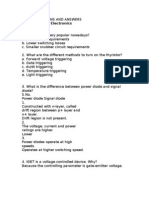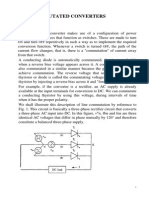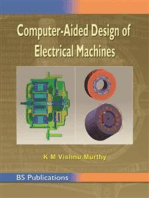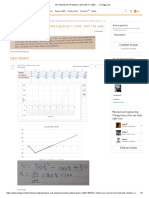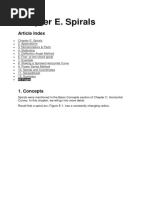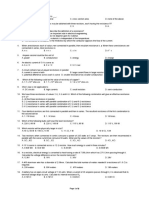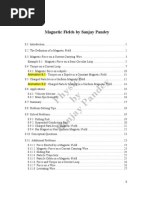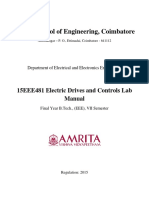Power Electronics Past Questions
Power Electronics Past Questions
Uploaded by
Sam MaosaCopyright:
Available Formats
Power Electronics Past Questions
Power Electronics Past Questions
Uploaded by
Sam MaosaCopyright
Available Formats
Share this document
Did you find this document useful?
Is this content inappropriate?
Copyright:
Available Formats
Power Electronics Past Questions
Power Electronics Past Questions
Uploaded by
Sam MaosaCopyright:
Available Formats
Power Electronics - Past Questions
Q1
A single-phase controlled full-wave bridge rectifier with an R-L load is operated with a delay
or firing angle < . The rectifier has supply voltage v V t
S m
sin . Sketch the circuit and
perform the following:
(i) With the aid of sketches of the waveforms for load voltage, vO(t) , and load
current, iO(t), analyze the circuit assuming discontinuous conduction mode
and show that
( ) ( )
( )
( )
R
L
R
L
L R Z
t
e t
Z
V
t i
t
m
O
,
`
.
|
+
]
]
]
and tan ,
for
sin sin ) (
1 2 2
where is the extinction angle. Hence, deduce the condition on for the
current to remain discontinuous.
[8 marks]
(ii) Repeat the analysis (include sketches of the waveforms for load voltage, vO(t) ,
and load current, iO(t) ) assuming continuous conduction mode. Show that
the average value of vO(t) is given by V
V
O
m
cos .
[8 Marks]
(iii) Given that the source is 220 V rms at 50 Hz and the load is R = 10 , L = 100
mH, determine whether the load current is continuous or discontinuous if =
60. Estimate the average load voltage.
[4 Marks]
Q2
A three-phase half-wave controlled rectifier is operated from a three-phase Y-connected
220-V (line-to-line), 60Hz supply. If the SCRs are fired at a delay angle of 120 deg and
given that the load is highly inductive with resistance R = 10 in series with a battery E
= -100 V, draw the rectifier circuit and calculate:
(i) the average and rms output voltages and currents,
(ii) the average and rms thyristor currents,
(iii) the output power,
(iv) sketch the waveforms of the output voltage, the output current, the thyristor
current, the source current of phase a, and the voltage across the thyristor
connected to phase a.
[16 Marks]
Q3
A bipolar junction transistor (BJT) is being used in a converter to switch, periodically, a
large inductive load that can be approximated as a constant current source. The BJT has
current fall- and rise-times (tf and tr respectively), as shown in Fig 3.
Sketch the waveform of the instantaneous power in the BJT and estimate
(i) the energy loss per cycle in the BJT during conduction
(ii) the energy loss per cycle in the BJT during both turn-off and turn-on
(iii) the average power loss in the BJT. [10
Marks]
1 / 8
v
Q
i
Q
t
s
t
r
t
s
t
I
L
V
S
v
Q(SAT)
t
f
t
0
t
1
t
2
t
3
Figure 3
Q4
Draw the load current waveform of a full-wave uncontrolled rectifier with a resistive load
current and. Hence,
(i) Express the load current as a Fourier series.
(ii) Calculate the ripple factor (RF) of the current using the expression in (i).
[6 Marks]
Q5
A three-phase half-wave controlled rectifier is operated from a three-phase Wye-connected
220 V, 60 Hz supply. If it is required to obtain an average output voltage of 50% of the
maximum possible output voltage for a resistive load of 10 , Sketch the converter circuit
and perform the following:
(i) derive expressions for the average and the rms output voltages,
(ii) calculate the delay angel ,
(iii) determine the input power factor of the converter,
(iv) sketch waveforms for io, vo, iT and vT. [10
Marks]
Q6
A half-wave controlled rectifier with a free-wheeling diode is supplied from a 120 V voltage
source. The load consists of R = 4 and L = 9 mH. If the thyristor T is fired at = 30
during each cycle, draw the circuit and perform the following:
(i) Sketch approximately to scale, the time variations of vi, ii, iL, iD, vo and vAK,
where the symbols have the usual meaning.
(ii) Obtain time dependent expressions for i and iD.
(iii) Calculate the average and rms values of iL, iD and vo. [10
Marks]
Q7
Figure 7 shows a step-down dc-dc converter. The switch is closed for a time DT and open
for (1 D)T where T is the switching period and D is the duty cycle.
It is assumed that all the components are ideal and that periodic steady-state conditions
have been established. If the capacitor is large enough for the output voltage to be
considered almost ripple-free,
(i) analyse the converter assuming continuous current mode and show that the
output voltage is given by D V V
S O
.
(ii) derive expressions for the average, maximum and minimum values of the
inductor current. Hence show that the minimum value of inductance required to ensure
continuous inductor current is
( )
f
R D
L
2
1
min
, where f is the switching frequency in Hz.
(iii) Also, show that the fractional peak-to-peak ripple present in the output voltage
can be estimated by
2
8
1
LCf
D
V
V
O
O
.
2 / 8
(iv) The buck converter in Fig 5 is required to deliver 25W output power with VS =
30V, f = 50kHz, and VO = 20V. Choose a value of inductance to ensure continuous
inductor current and a value of capacitance to ensure peak-to-peak ripple less than 1%.
[14 marks]
Q8
The current drawn by a converter is represented by the waveform shown in Figure 8. Use
Fourier analysis to determine an expression for obtaining the rms values of the
fundamental and the harmonics of the load current. Hence, express the rms value of the
fundamental as well as the first few harmonics of the waveform.
[6 marks]
Fig. 8 Input current waveform of a single phase converter.
Q9
A sinusoidal voltage of t sin 240 V is applied to a single-phase converter, the input current
of which is represented by the waveform of Figure 8. Assume that the zero crossing of the
current waveform is 30 behind that of the input voltage waveform. If the peak value of the
current waveform is 10 A, calculate:
(i) the average power drawn by the converter,
(ii) the input displacement factor,
(iii) the input distortion factor,
(iv) the total harmonic distortion (THD%) of the input current and
(v) the input power factor of the converter. [10
marks]
Q10
A single-phase full-bridge full-wave uncontrolled bridge rectifier supplies a very high
inductive load (dc motor). The turns ratio of the transformer is unity. If the load is such
that the motor draws a constant armature current of Ia, perform the following:
(i) Sketch the converter circuit and the waveforms for the supply and load
currents,
3 / 8
F
i
g
.
7
L
R
D
V
S
i
L
i
C
i
D
V
O
C
v
L
v
D
i
R
i
S
(ii) Determine the %THD of the input current and the input power factor of the
rectifier.
[10 Marks]
Q11
A three phase bridge rectifier supplies a load at a dc voltage of 300 V and current of 30 A
from a 415 V three phase supply via a delta-star transformer. Sketch the circuit and
determine the required diode and transformer specifications. Assume all diode forward
drops to be 0.7 V and that the load draws a continuous, ripple-free current.
[10 Marks]
Q12
A single-phase full-bridge controlled rectifier is connected to a 120V, 60Hz supply. The
average load current is continuous with negligible ripple content (highly inductive load).
The transformer turns ratio is unity. The load has resistance R = 5 and E = 12 V. If the
delay angle is = 60, sketch the circuit and hence perform the following:
(i) Calculate the average output voltage Vdc and current Idc.
(ii) Express the input current in a Fourier series and use it to determine
The THD of the input current.
The displacement factor DF.
The input power factor PF.
The PIV of the thyristors.
(iii) Sketch the waveforms of the load voltage vo, the load current io, the input
current is and the voltage across one of the thyristors.
[15 Marks]
Q13
A buck converter delivers 5V into a 1 load when supplied from a 12 V battery source. The
switching period is 24 s and voltage ripple in the converter output is assumed to be
negligible.
(a) Draw the converter circuit showing the supply voltage, all converter components,
and the load. `
[3 Marks]
(b) Considering ideal components, and a continuous mode of operation, find the
chopper duty-cycle.
[2 Marks]
(c) Find the converter inductance for a 20% current ripple, assuming ideal components.
[5 Marks]
(d) If it is later determined that the converter inductance has a winding resistance of
0.2 and that the battery can be modelled as an ideal 12 V source with source
resistance of 0.4 ,
1(i) What value of the chopper duty cycle will maintain the output at 5 V?
2(ii) Calculate the power drawn from the ideal 12 V source of the battery.
(iii) What is the power dissipated in the battery?
(iv) Determine the power delivered by the converter to the load. [10
Marks]
(Sketch waveforms to illustrate your working where necessary)
Q14
Figure 14 shows a battery charging circuit. The battery voltage is E = 12 V and its capacity
is 100 Wh. The average charging current should be Idc = 5 A. The primary input voltage is
Vp = 120 V rms, 60 Hz and the transformer turns ratio n = 2:1. Sketch the waveforms of
4 / 8
the input (secondary) voltage vs, the charging current io, and the diode voltage vd, and
calculate:
(iv) the conduction angle of the diode,
(v) the current-limiting resistance R,
(vi) the power rating PR of R,
(vii) the charging time in hours,
(viii) the PIV of the diode. [12
Marks]
Figure 14 A battery charging circuit.
Q15
A single-phase centre-tapped diode rectifier supplies a purely resistive load of R = 10 .
The primary input voltage is Vp = 120 V rms, 60 Hz and the transformer turns ratio n = 2:1.
Sketch the converter circuit and perform the following:
(i) determine the average load current Io,dc,
(ii) determine the rms value of the load voltage Vo,rms,
(iii) sketch the waveforms of the load current, the load voltage, and the voltage
across one of the diodes.
[8 Marks]
Q16
A three-phase full-wave controlled rectifier is operated from a three-phase Y-connected
220-V (line-to-line voltage), 60Hz supply. The load is highly inductive with a resistance R =
5 in series with a battery E = 20 V. If the delay angle = 75, sketch the circuit and
calculate
(i) The average output voltage.
(ii) The rms and average output currents.
(iii) The average and rms thyristor currents.
(iv) The output power.
(v) Sketch the waveforms of the output voltage, the output current, the thyristor current, and
the voltage across one of the thyristors. [14 marks]
Q17
A single-phase half-wave phase-controlled rectifier with a free-wheeling diode D is
supplied from a 120 V rms, 60Hz voltage source. The load consists of R = 4 and L = 9
mH. If the thyristor T is fired at = 30
during each cycle, draw the circuit and perform
the following:
(i) Sketch the time variations of vs, iT, iD, io, vo and vAK, where the symbols have
their usual meaning.
(ii) Obtain time dependent expressions for iT and iD and verify that the load
current is discontinuous.
(iii) If the extinction angle is numerically computed to be 4.2 radians, calculate
the average and rms values of io and vo.
[12 Marks]
Q18
A three-phase half-wave phase-controlled thyristor rectifier is operated from a three-phase
Wye-connected 220 V rms, 60 Hz supply. If it is required to obtain an average output
5 / 8
voltage of 50% of the maximum possible output voltage for a resistive load of 10 , sketch
the converter circuit and perform the following:
(i) derive expressions for the average (Vo,dc) and the rms (Vo,rms) output
voltages,
(ii) calculate the delay angle ,
(iii) calculate the input power factor of the converter,
(iv) sketch waveforms for io, vo, iT and vT, where the symbols have their usual
meaning.
[10 Marks]
Q19
A step-down dc-dc converter is operated by closing a switch for a time DT and opening it
for (1 D)T, where T is the switching period and D is the duty cycle. Assuming ideal devices
and components and periodic steady-state conditions, draw a well labeled circuit diagram
of the buck converter and:
(i) Analyze the converter assuming continuous conduction mode and show that
the output voltage is given by D V V
s o
, where Vs and Vo are the supply and
output voltages respectively. Assume the capacitor is large enough for the
output voltage to be considered almost ripple-free.
(ii)Derive expressions for the average, maximum and minimum values of the
inductor current and hence obtain an expression for the minimum value of
inductance required to ensure continuous inductor current.
(iii) Obtain an expression that can be used to estimate the fractional peak-to-
peak ripple present in the output voltage.
[12 marks]
The buck converter above is required to deliver 20W output power with VS = 30 V, f =
60 kHz, and VO = 20 V. Choose a value of inductance to ensure continuous inductor
current and a value of capacitance to ensure peak-to-peak ripple less than 2%.
[4 marks]
Q20
The speed of a separately excited d.c. motor is controlled by a single-phase full-wave
thyristor rectifier. The field circuit is also controlled by a similar full-wave converter. The
input voltage to both the armature and field converters is single-phase 440V rms, 60Hz.
(v) Draw a well labelled circuit of the separately-excited d.c. motor drive.
(vi) The armature resistance Ra = 0.25 , the field circuit resistance Rf = 175
, and the motor voltage constant is Kv = 1.4 V/A-rad/s. The armature
current corresponding to the load demand is Ia = 45 A. If the inductances
of the armature and field circuits are sufficient to make the armature and
field currents continuous and ripple-free, and given that the delay angle
of the armature converter is a = 60, determine:
[1] the torque developed by the motor, Td,
[2] the motor speed, ,
[3] the input power factor of the drive.
(Neglect viscous friction and no-load losses) [10
Marks]
Q21
Highlight the main factors on the basis of which a power switching device for a given
application may be chosen.
[4 Marks]
Q22
Explain the reverse recovery characteristic of a power diode. [4 marks]
Q23
6 / 8
Define and give expressions for the following parameters of a power converter:
(i) Form factor
(ii) Ripple factor
(iii) Total harmonic distortion. [6 marks]
Q24
Draw labelled sketches of the real as well as idealized i-v characteristics of the following
power semiconductor devises. Briefly explain the characteristics.
(i) power BJT,
(ii) thyistor,
(iii) power diode. [4
marks]
Q25
Draw the I-V characteristics of an SCR (thyristor) and explain its operation in a simple
resistive load circuit supplied by an a.c voltage source. [6 marks]
Q26
Explain the base/gate drive requirements for the following power switching devices:
(i) BJT
(ii) GTO
(iii) MOSFET [6 marks]
Q27
With the aid of circuit diagrams and waveforms, discuss the operation of two different
types of single-phase uncontrolled full-wave rectifiers and compare the PIV of the diodes
for each case. [8 Marks]
Q28
List the main factors that decide the choice of power switching device for a given
application.
[2 Marks]
Q29
With the aid of waveforms, explain the turn-on and turn-off characteristics of a practical
switching device. Give an expression for the power dissipation of the switching device.
[6 marks]
Q30
State and explain at least four important specifications of semiconductor switching devices
to be found in manufacturers data sheets.
[8 marks]
Q31
What is a snubber circuit? Explain the reason for using a snubber circuit in series or across
a power switching device.
[3 marks]
Q32
State the preferred switching device for the following applications:
(i) Line frequency high power applications.
(ii) Forced commutated high power applications.
(iii) Low and medium power applications. [3 marks]
Q33
With the aid of a block diagram, illustrate the generalized structure of a power converter.
[2 marks]
Q34
State five indicators of the power processing quality of a power converter and explain
briefly how these may be evaluated.
[6 marks]
Q35
7 / 8
With the aid of sketches of their characteristics, differentiate between a thyristor and a
Triac.
[5 marks]
Q36
State and explain at least four important specifications of semiconductor switching devices
provided in manufacturers data sheets.
[6 marks]
Q37
Briefly explain what is meant by a d.c. chopper. [4 marks]
8 / 8
You might also like
- Industrial Drives and ControlsDocument4 pagesIndustrial Drives and ControlsMohit SanandiyaNo ratings yet
- PE Lecture No 03Document12 pagesPE Lecture No 03Getnet YilfuNo ratings yet
- Lab Report Solayman Ewu - CompressDocument12 pagesLab Report Solayman Ewu - CompressVic100% (1)
- Power Electronics Open Book ExamDocument4 pagesPower Electronics Open Book Examعبودي الامين100% (1)
- Pe SS Final Ex 2010Document4 pagesPe SS Final Ex 2010Saif UddinNo ratings yet
- Design of Electrical Circuits using Engineering Software ToolsFrom EverandDesign of Electrical Circuits using Engineering Software ToolsNo ratings yet
- Operation of A DSTATCOM in Voltage Control ModeDocument7 pagesOperation of A DSTATCOM in Voltage Control Modeswathi_ammalu007No ratings yet
- Bee4223 - Power Electronics & Drives SysDocument9 pagesBee4223 - Power Electronics & Drives Sysdinie90No ratings yet
- Assignment Electric DriveDocument2 pagesAssignment Electric DriveRajanNo ratings yet
- Chapter 1 DC Drives Part1Document46 pagesChapter 1 DC Drives Part1Mohammad MunzirNo ratings yet
- DC Motor Speed Control by Four Quadrant ChopperDocument12 pagesDC Motor Speed Control by Four Quadrant ChopperSokNov NaiNo ratings yet
- Power Electronics Lab ReportDocument4 pagesPower Electronics Lab ReportOmr Darwish100% (1)
- Bridge RectifierDocument23 pagesBridge RectifierSidhu S KumarNo ratings yet
- Transformers & EM Conversion PDFDocument75 pagesTransformers & EM Conversion PDFAbraham OseitutuNo ratings yet
- Resonant InverterDocument34 pagesResonant InverterFemi PrinceNo ratings yet
- Department of Electrical & Electronics Engg.: BEV Sem (Ex) Experiment No - 1 Aim: Apparatus RequiredDocument44 pagesDepartment of Electrical & Electronics Engg.: BEV Sem (Ex) Experiment No - 1 Aim: Apparatus Requiredvkdkris75% (4)
- CH4 2Document55 pagesCH4 2Imran AbdullahNo ratings yet
- L9 Single Phase VSIDocument114 pagesL9 Single Phase VSIPrashant Surana100% (1)
- Assignment Problems HVDCDocument2 pagesAssignment Problems HVDCSelva KumarNo ratings yet
- CH2Document55 pagesCH2Shantha KumarNo ratings yet
- Network Theory Lab ManualDocument31 pagesNetwork Theory Lab ManualkondraguntajbNo ratings yet
- Parameters Which Effect Real and Reactive Power Flow: I I E X+ZDocument12 pagesParameters Which Effect Real and Reactive Power Flow: I I E X+ZvenkatNo ratings yet
- Course Plan-Power ElectronicsDocument5 pagesCourse Plan-Power ElectronicsNarasimman DonNo ratings yet
- Chapter 4 - Ac BridgesDocument53 pagesChapter 4 - Ac Bridgesking75% (4)
- 2.simulation of Single Phase Full Bridge Converter Using LTspiceDocument10 pages2.simulation of Single Phase Full Bridge Converter Using LTspiceabcdefg0% (1)
- Buck ConverterDocument8 pagesBuck Converterhamza abdo mohamoudNo ratings yet
- Concordia University Department of Electrical and Computer Engineering ELEC 6411 - Power Electronics I Course Outline Fall 2015 Course InstructorDocument30 pagesConcordia University Department of Electrical and Computer Engineering ELEC 6411 - Power Electronics I Course Outline Fall 2015 Course InstructorAndrewJohnsonJenssonNo ratings yet
- IGEE 402 - Power System Analysis Final Examination - Sample Fall 2004Document28 pagesIGEE 402 - Power System Analysis Final Examination - Sample Fall 2004Akinbode Sunday OluwagbengaNo ratings yet
- Electromagnetic Field Theory A Collection of ProblemsDocument282 pagesElectromagnetic Field Theory A Collection of ProblemsJhonatan Perez EspinozaNo ratings yet
- DC ChoppersDocument38 pagesDC Chopperspsoumya50% (2)
- Ac DC PWMDocument6 pagesAc DC PWMIrfan AliNo ratings yet
- Worked ExamplesDocument11 pagesWorked ExamplesAli AltahirNo ratings yet
- Lecture 5 - Single Phase Full Bridge VSCDocument12 pagesLecture 5 - Single Phase Full Bridge VSCAfsal Abdul KarimNo ratings yet
- DC Motor - Drive 2019Document80 pagesDC Motor - Drive 2019ali ramadanNo ratings yet
- Cha:3 Special Instruments: Power Factor Meter Frequency Meter Synchroscope Phase Sequence IndicatorDocument25 pagesCha:3 Special Instruments: Power Factor Meter Frequency Meter Synchroscope Phase Sequence IndicatorNirav ChauhanNo ratings yet
- Lab Final Exam Answer PDFDocument4 pagesLab Final Exam Answer PDFhelen tsegayNo ratings yet
- Derive Basic Gate Using NOR GateDocument3 pagesDerive Basic Gate Using NOR GateShravan Kumar NamdeoNo ratings yet
- Electrical MachinesDocument66 pagesElectrical MachinesHrushi KesanNo ratings yet
- Power Electronics Question BankDocument20 pagesPower Electronics Question BankNitesh KumarNo ratings yet
- Group5 Lab 09Document6 pagesGroup5 Lab 09FALSERNo ratings yet
- AC-DC Converter - Single PhaseDocument30 pagesAC-DC Converter - Single Phasebishnu prasad muni100% (1)
- A McMurray InverterDocument2 pagesA McMurray Inverteranshu71% (7)
- Symmetrical Fault AnalysisDocument12 pagesSymmetrical Fault AnalysisHONAR DUHOKINo ratings yet
- Ac Voltage Controller Using Thyristor Project Report by SandeepDocument29 pagesAc Voltage Controller Using Thyristor Project Report by SandeepSANDEEP DHANDA100% (1)
- Cut Set EtcDocument40 pagesCut Set Etcpalashkatiyar1234No ratings yet
- I DT DT DT DT: Class Notes On Electrical Measurements & InstrumentationDocument71 pagesI DT DT DT DT: Class Notes On Electrical Measurements & InstrumentationTia Nur AmaliahNo ratings yet
- 3 Line ConverterDocument10 pages3 Line ConverterJay Romar PabianiaNo ratings yet
- Series Resonant Inverter With Bidirectional Switch: ECE 442 Power Electronics 1Document27 pagesSeries Resonant Inverter With Bidirectional Switch: ECE 442 Power Electronics 1mrboyedNo ratings yet
- What Is R.M.S (Root Mean Square) ?Document5 pagesWhat Is R.M.S (Root Mean Square) ?Muhammad UmairNo ratings yet
- Draw The Block Diagram of Electric Drive SystemDocument9 pagesDraw The Block Diagram of Electric Drive SystemcoolkannaNo ratings yet
- Electrical Ciruit Analysis PDFDocument582 pagesElectrical Ciruit Analysis PDFMohammed SabeelNo ratings yet
- Power System Lab ManualDocument17 pagesPower System Lab ManualhavejsnjNo ratings yet
- Electrical Machines: Lecture Notes for Electrical Machines CourseFrom EverandElectrical Machines: Lecture Notes for Electrical Machines CourseNo ratings yet
- Simulation of Some Power Electronics Case Studies in Matlab Simpowersystem BlocksetFrom EverandSimulation of Some Power Electronics Case Studies in Matlab Simpowersystem BlocksetNo ratings yet
- Copy of تقرير انكليزيDocument7 pagesCopy of تقرير انكليزيabody.alhadithy00No ratings yet
- Electromagnetic Theory, Photons, and Light: OpticsDocument29 pagesElectromagnetic Theory, Photons, and Light: OpticsLatifaKhumairaNo ratings yet
- Chapter 2 2-001.2 (Basis) PDFDocument4 pagesChapter 2 2-001.2 (Basis) PDFJamiel CatapangNo ratings yet
- Conductors & Insulator Grob's Basic Electronics-11ed-12Document5 pagesConductors & Insulator Grob's Basic Electronics-11ed-12Taufiq Fahlifi YfzerobrrNo ratings yet
- Electrostatics and Magnetostatics Cheat PDFDocument5 pagesElectrostatics and Magnetostatics Cheat PDFjamesNo ratings yet
- Schrack Safety Relay SR6: General Purpose RelaysDocument4 pagesSchrack Safety Relay SR6: General Purpose RelaysRiotobyNo ratings yet
- Design of Circular CurveDocument23 pagesDesign of Circular CurvesamuthrarajaNo ratings yet
- Cerberus v14 - 5 Release SummaryDocument2 pagesCerberus v14 - 5 Release SummaryFranklin NavarroNo ratings yet
- CBSE Board Practical Project To Study The Variance of Resistance Using LDRDocument12 pagesCBSE Board Practical Project To Study The Variance of Resistance Using LDRSharan Raj100% (1)
- EE-Exam-DC - Ckt-1 - P-AC - Ckt-Feb-2021 QuestionnaireDocument6 pagesEE-Exam-DC - Ckt-1 - P-AC - Ckt-Feb-2021 QuestionnaireGlenn Paul PaceteNo ratings yet
- (Newton's Laws of Motion, Friction, Work and Energy) : 0, ThenDocument12 pages(Newton's Laws of Motion, Friction, Work and Energy) : 0, ThenAbraham BanjoNo ratings yet
- Standing Waves On Strings!Document4 pagesStanding Waves On Strings!Atif ImamNo ratings yet
- PAF Past Papers of GDPDocument12 pagesPAF Past Papers of GDP16bsmaths19454No ratings yet
- GEMSS Medical NHFG Service ManualDocument27 pagesGEMSS Medical NHFG Service ManualFidel Eduardo MontenegroNo ratings yet
- 01 KDOM Course HandoutDocument14 pages01 KDOM Course HandoutBhimsen ShresthaNo ratings yet
- Linearized Supersonic Flow: Lecture Notes Presented by C.R. PrajapatiDocument14 pagesLinearized Supersonic Flow: Lecture Notes Presented by C.R. PrajapatiChetan PrajapatiNo ratings yet
- Q&As L4.Document32 pagesQ&As L4.Chalez ZengeretsiNo ratings yet
- Eeeviews: Unit Iv Synchronous Motor DrivesDocument26 pagesEeeviews: Unit Iv Synchronous Motor Driveskrithikgokul selvamNo ratings yet
- Absolute Rotary EncoderDocument4 pagesAbsolute Rotary EncoderRezaadityamuhaNo ratings yet
- Nanomaterial Characterization Techiniques by Kunsa H. of EthiopiaDocument79 pagesNanomaterial Characterization Techiniques by Kunsa H. of Ethiopiaእግዚአብሔር ይመስገን አመንNo ratings yet
- Vacon NXC User Manual DPD00890B UKDocument112 pagesVacon NXC User Manual DPD00890B UKirfanWPKNo ratings yet
- Gujarat Technological University: Electrical Engineering (09) Subject Code: B.E. 6 SemesterDocument5 pagesGujarat Technological University: Electrical Engineering (09) Subject Code: B.E. 6 SemesterHod EeeNo ratings yet
- Magnetism (Sanjay Pandey)Document28 pagesMagnetism (Sanjay Pandey)Sanjay PandeyNo ratings yet
- Advanced Fluid Mechanics: SS 2020 Prof. Dr. O. EiffDocument6 pagesAdvanced Fluid Mechanics: SS 2020 Prof. Dr. O. EiffCamille CrnNo ratings yet
- Drives and Control Lab ManualDocument36 pagesDrives and Control Lab ManualKabilanNo ratings yet
- Axial Leaded - 600W P6KE SeriesDocument5 pagesAxial Leaded - 600W P6KE SeriesSamrul YoNo ratings yet
- GATE 2020 Trishna SolutionsDocument464 pagesGATE 2020 Trishna SolutionsCHARLIE PARKERNo ratings yet
- Investigation of Performance Parameters of PMSM Drives Using DTC-SVPWM TechniqueDocument6 pagesInvestigation of Performance Parameters of PMSM Drives Using DTC-SVPWM TechniqueBook4AllNo ratings yet
- Sim of Tyre Rolling Resistance Final RevDocument26 pagesSim of Tyre Rolling Resistance Final RevManutenção de Pneus Unidade Santa CândidaNo ratings yet
- Copper Clad Ground Rod PDFDocument5 pagesCopper Clad Ground Rod PDFAmiableimpexNo ratings yet









































